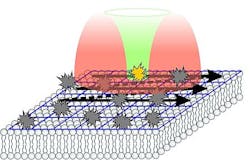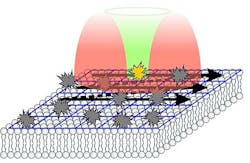Spectroscopy, fluorescence microscopy combo observes moving molecules in live cells
By combining raster image correlation spectroscopy (RICS) with stimulated emission depletion (STED) fluorescence microscopy, researchers at the Karlsruhe Institute of Technology (KIT) in Germany opened up new applications in medical research, such as analyzing the dynamics of cell membranes at high protein concentrations. The newly developed STED-RICS microscopy method records rapid movements of molecules in live samples.
Related: Microscope breakthrough enables watching and measuring molecules in living cells
Using a confocal scanning microscope, fluorescence images are recorded point by point at fixed time intervals; therefore, the images contain an implicit time structure. This information can be used with the help of RICS to determine the dynamics of biomolecules, such as proteins, in live cells, or tissue samples. However, protein concentrations often are too high to apply RICS together with conventional microscopy. For this reason, the researchers combined the RICS method with STED microscopy; when using STED, the light spot scanning the fluorescence image can be reduced considerably. This method has already been used successfully to reach a maximum resolution in the imaging of cells, and its resolution is not limited by the Abbe limit.
By combining RICS with STED microscopy, the researchers quantified molecule dynamics in biological structures based on the raster images recorded. âThis means that the STED-RICS method can be used to derive from any fluorescence image a highly resolved map of the number and movability of the marked molecules in the area scanned by the spot,â explains Prof. Gerd Ulrich Nienhaus, who led the work.
The STED-RICS method opens up new measurement applications in life sciences, mainly research into the dynamics of cell membranes. Numerous receptor proteins are embedded in the membranes. By interaction with externally docking ligand molecules, external signals are transmitted into the cell. With the help of STED-RICS, the researchers can now determine precisely and quantitatively the movements of both lipids and receptors. Understanding these processes is crucial for medical and pharmaceutical research; many pharmaceutical substances are based on influencing these interactions. âAbout every second medical substance influences signal transduction of G-protein coupled receptors, an important sub-class,â Nienhaus explains.
Nienhaus' research team worked with scientists from the Institute of Toxicology and Genetics (ITG) and the Cell and Developmental Biology Division of the Zoological Institute.
Full details of the work appear in the journal Nature Communications; for more information, please visit http://bit.ly/17DcGzj.
-----
Follow us on Twitter, 'like' us on Facebook, and join our group on LinkedIn
Subscribe now to BioOptics World magazine; it's free!

